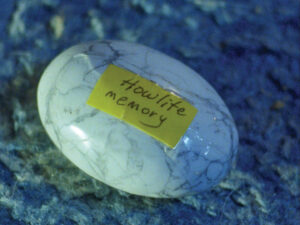Experimental filmmaker Kara Hansen currently works as a film instructor in the US, but she’ll be travelling back home to the west coast for a screening of her work at Victoria’s Antimatter Film Festival this month. The festival features all kinds of work that challenge the conventions of what sharing art can look like.
“It’s not just filmmakers, but it brings media arts in general into conversation,” says Hansen, who is originally from Vancouver. “So there’s going to be installations and screenings… It’s also really non-industry, and it feels like the kind of film festival that’s really about forming relationships between artists and other makers and audience members.”
Hansen creates a specific kind of film called film portraits or video portraits. While paintings or photography capture a subject in a frozen moment, film portraits seek to capture the way a subject moves through time and space more literally.

“I guess portraiture is also tracking various states,” says Hansen, “like, what are the states that that person experiences, whether that’s like joy or periods of contemplation? How do we show transformation in terms of cinematic time?”
Hansen’s Semi-Precious, screening at Antimatter, is especially close to Hansen’s heart, with her having an intimate relationship with the film’s subject at a point of transition.
“It’s about my mother… We didn’t know what it was for a long time, but she has dementia,” says Hansen. “And so it’s sort of about the disintegration of language, and how we put language into practice.”
Hansen says that she works through collage as a medium.
“I know that these are the items that I have, or the locations that I have at my disposal,” she says, “and they inform traces of this person and their passage through that space, or their imprint.”
Hansen’s mother worked most of her professional life as a holistic practitioner, so to capture her habits and mannerisms Hansen used the environment she was most herself in.
“Throughout the film [we use] different crystals and supplements and objects around the house that are labelled with either the way that the object can help restore a sense of balance, like emotional or physical, or some of the labels are more abstract, and I don’t know what they mean,” she says. “I think they’re kind of her mnemonic system, really, to recall what they do.”
The crystals themselves tie into another theme of the film. As Hansen worries how much time she has left with her mother, she begins to think about time as a more relational element.
“I think it’s about rocks too, or the parallel between an aging person [and] the possibility, outside of human time, of geologic time, what it means to be human on this earth,” she says. “You look at the moon, [which is] like the oldest rock form, every day, and it has these symbols, or meta historic value in relation to motherhood as the child of the Earth.”
As the portrait was captured, much of the filming itself was playfully making space to remind her mother who she is and what she enjoys doing.
“The process of making it was reminding her of what she does and what, you know, is important to her and what, not that it defines her, but it definitely has shaped her perception of the world,” says Hansen. “I think trying to find entry points to her perception that is quite unique and spiritual was important to try to do.”
Diving into her mother’s world and perspectives was important for the portrait, but more than that it was about capturing the things about her mother that she’ll cherish forever. The portrait taker is necessarily always in the portrait by virtue of the image itself being their point of view. In this portrait, the depth of the relationship, its history, and the tenderness shared in the process of change is felt strongly.
“Throughout the film there’s an established trust,” says Hansen.
Antimatter
Various times,
Thursday, October 17 to Sunday, October 27
Various prices and venues
antimatter.squarespace.com
